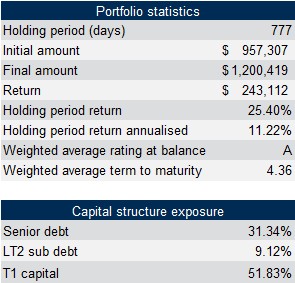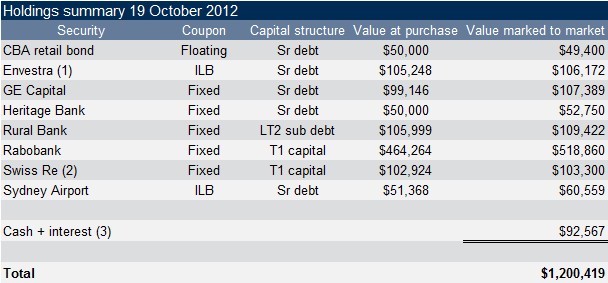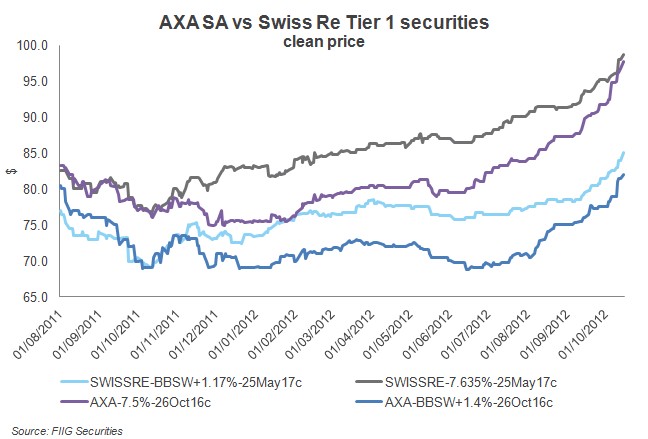by
Elizabeth Moran | Oct 23, 2012
Bond markets continue to rally with the risk trade still on despite little change in fundamentals. It’s meant that Tier 1 hybrid securities sitting low in the capital structure in the over-the-counter market have had significant price appreciation with many now trading near or over $100, especially those that have fixed rate interest payments (coupons).
This has served my portfolio well. When I first set out the portfolio in September 2010, I had a view that interest rates would move lower, so had a preference for fixed rate bonds. These have all appreciated nicely with Rabobank, GE, Rural Bank (Bendigo and Adelaide Bank) and AXA SA all appreciating so the annualised return on my portfolio is 11.22% over the period (see Figure 1).


Figure 1
Assumptions and previous holdings:
1. QTC was sold and Envestra was purchased on 30 July 2012
2. AXA SA was sold and Swiss Re purchased on 16 October, trade settled 19 October 2012
3. Cash accumulated from coupon payments and added to the existing At Call account, interest is calculated using RaboDirect rates.
Current cash holdings including accumulated interest on the account is $92,567.00, I withdrew $43,050.00 for the purchase of Envestra ILB (30 July 2012) and $5,317.00 (capital difference) for the purchase of Swiss Re (19 October 2012)
4. Prices include accrued interest
Macquarie bond matured 31 May 2012, funds then used to buy Heritage 7.25% fixed rate bond
Credit union term deposit invested in CBA retail bond
The AXA SA Tier 1 hybrids are the highest risk investment in the portfolio and while I’ve been comfortable with the European risk and the possibility of non-call in 2016, they have had significant price appreciation. So, I made the decision to sell these securities and crystallise the profit and reinvest elsewhere. Had I had a larger parcel of the AXA SA, I would have sold down a portion, but I hold the minimum parcel size, so have sold my total holdings. I made the sale on the ex-coupon date (19 October 2012), so achieved the most recent high coupon payment and still achieved a $97.75 sale price. I originally bought the hybrids for $85.65, meaning I’ve made a capital gain on those securities of 14.13%. I think that with the price near $100 and that’s what I’d hope to get at first call in October 2016, that there’s greater downside risk than upside at this point. Should market fundamentals prevail – low global growth, recessions in many parts of Europe and I think most importantly a US slowdown after the election, then the prices of these securities could well fall.
Trying to balance a good return with low risk is increasingly difficult as the price of risk assets everywhere has increased. I’d still like low risk high yield securities and I’ve taken the opportunity to buy the Swiss Re fixed rate Tier 1 hybrid in place of the AXA SA Tier 1 hybrids. The features of the two securities are similar, although the Swiss Re is longer dated with first call in May 2017. Both companies are insurers, although have different domiciles AXA SA is French with its main markets being Life and Personal insurance, while Swiss Re is obviously Swiss based and a global reinsurer.
In making the switch between the securities, the Swiss Re cost is $99.75, so price difference of $2.00 which is a slight cost in terms of bond price and income will be slightly lower but the Swiss Re credit is stronger so improves the overall risk profile of my portfolio. AXA SA Tier 1 hybrid is rated BBB, while the Swiss Re Tier 1 hybrid is rated A, which gives me a three notch improvement.
I’m still very much of the view that interest rates will be lower for longer, so want to maintain the fixed portion of my portfolio for the time being. There may be a point where I switch this security for the floating rate note equivalent, but not yet. Again, had I held a greater parcel of the AXA SA hybrids, I think switching a portion into the floating rate equivalent would have been a good option.
Figure 2 compares the prices of the AXA SA hybrid and the Swiss Re hybrid. The purple line shows the very steep appreciation of the AXA SA fixed. The Swiss Re fixed is the grey line, while the two blue lines show the pricing of the floating rate equivalents, which still trade well-below $100, offering that capital gain at first call.

The other security to make note of is the Rabobank Tier 1 hybrid with first call of December 2014. This hybrid is now trading at a premium of $101.75. If I chose to sell this security, I would make a capital gain of over $50,000, which is very attractive but on the flipside it’s earning very good coupons and I want to maintain that income for the moment. So, it’s a bit of a toss-up as to whether I maximise capital gain; this security could increase in price still or hang onto a valuable fixed income stream. I’m sticking with it for the moment but I will look to sell this security in the next 12 months as I will only get $100 face value back at first call (assuming the bank call at the first opportunity).
I’m holding around $92,000 in cash and plan to buy another security, but am tossing up whether to go for fixed or floating and I really feel that while interest rates are still forecast to move lower, I have enough fixed rate exposure. The discounts being offered by floating rate notes appeal. In my next column I’ll show you a basic calculation as to how we work out whether to opt for a fixed or floating security issued by the same issuer with the same maturity.
Note: I would not necessarily recommend this portfolio for new investors. AXA SA and Swiss Re hybrids are only available to wholesale investors. All prices and yields are a guide only and subject to market availability. FIIG does not make a market in these securities.